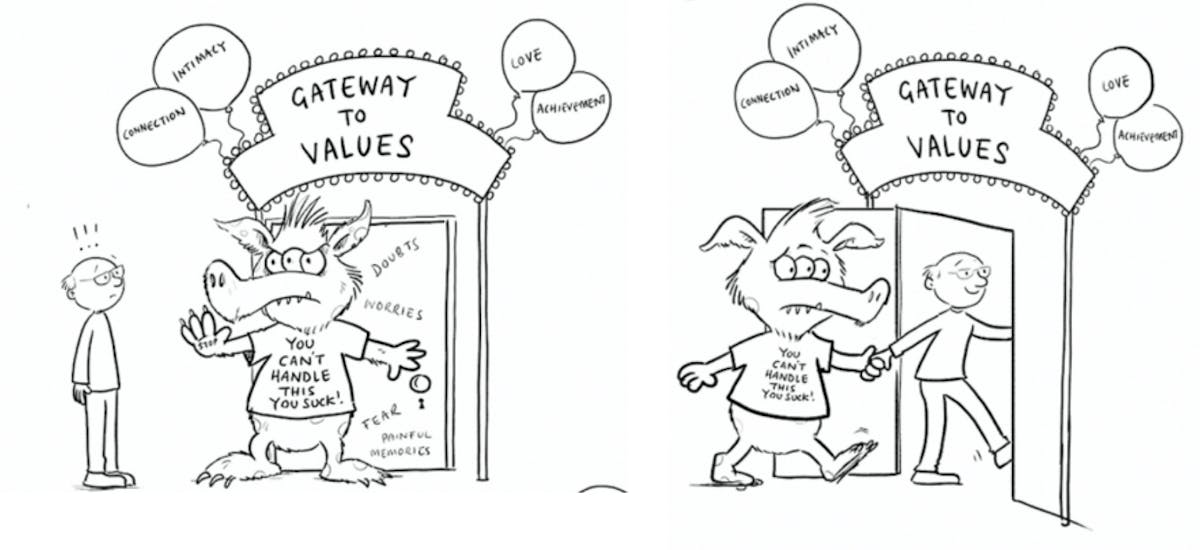In today’s work environment, we must meet all sorts of expectations and deadlines, be constantly ahead of the game, excel in leadership, and at the same time be innovative and agile. And if you don’t have an environment where people feel safe to; be themselves, share their opinions, disagree with each other, and take risks, it’s very hard to achieve any of those things.

How to build a better relationship with the bully living inside your head
Have you ever noticed that there seems to be a person living in your head, offering you snarky comments every time you are trying to do something outside of your comfort zone?
If you have no idea what I’m talking about, maybe this scenario will help you see what I mean.
Think of something that you have been wanting to do for a while, a project you have been thinking about or an opinion you’ve been wanting to express. What unhelpful thoughts arise as you think about doing this?

As I’m writing this blog post my mind is telling me all sorts of nasty things such as “You are not a writer, stop trying”, “You don’t know enough about this”, “No one will read this, stop wasting your time.” and, the most ruthless one that puts a sudden end to most of my dreams and ideas, “You are not good enough”.
Recognize any of these? Do you also notice that they aren’t helpful or supportive but actually rather mean, kind of like the bully in school?
What’s peculiar about these thoughts is that we all seem to think that we are the only ones that have. And yet, it’s one of the most human things there is. I have them. You have them and Mo Gawdat, Google X’s former Chief Business Officer has them. In fact, the human mind has been programmed to create these kinds of thoughts as a way to survive.
“Why?”, you might ask.

Ever noticed how you pay attention to negative comments a lot more than positive ones? That's the negativity bias in action. Illustration by: Gemma Corell
Humans have been programmed over millennia to pay attention to what’s negative because it has helped us survive. The humans who noticed that there was less fruit on the trees one season, and could not get that thought out of their heads, were more likely to start looking for an alternative food source. As a result, they were more likely to survive and pass on their genes. This has been studied quite intensively and it’s called the negativity bias.
This combined with the fact that humans have evolved in tribes has made us pay special attention to anything potentially threatening that might exclude us from our tribe, because being excluded from our tribe used to mean the end of us.
If you pay attention you will notice that these snarky comments usually aren’t present as you are sitting comfortably on your sofa about to watch another episode of your favorite series, but arise as you start working towards an important goal of yours. Suddenly thoughts along the lines of “that will never work”, “people will laugh at me”, “I’m a fraud, and people will see it” start to pop up in our heads.
It’s as though there is a bully living in our heads. But your brain is actually just doing what it is supposed to, keep you alive by protecting you from potential threats, so it’s more like an overprotective mother constantly telling you not to go there or do that because you might hurt yourself.
So what’s so bad about this bully living in your head?
If we give the bully too much attention, it’s easy to start to believe that what they are saying is true and we are in fact “really boring”, “not smart enough” etc. We let the bully define who we are.
How we see ourselves dictates a lot of our behaviors. A person who thinks of themselves as boring will likely live a life where being boring isn’t a problem. They might avoid talking to people they find interesting because they are scared that person will think they are boring. They might look for a career where being boring’ won’t be much of an issue. They might stay away from social events where they have to talk to strangers, etc.
Want to build a better relationship with the bully living inside your head?
What can we do about the bully in our heads?
This of course is not a new phenomenon and therefore, there are many potential solutions. And chances are you have tried some of them.
When the bully gets too loud you might have tried to distract yourself by going for a run or eating a bowl of crisps or smoking a joint. And this gives us a moment of relief, of course, but only for the moment.
You might have tried to fight the bully by putting positive affirmations about yourself on your computer screen along the lines of “I’m awesome”, “I got this” etc. And this also works for a bit. But research clearly shows that in the long-run, this is also not a helpful strategy.
What ACT (Acceptance and Commitment Therapy, an evidence-based form of therapy under the umbrella of Cognitive Behavioural Therapy) suggests is a completely different approach - let the bully hang around and accept them as a part of you, but don’t let them run the show.

What happens when you let the bully run the show VS when you allow it to come along. Illustration by Act Auntie
Acceptance does not mean surrender because that wouldn’t be helpful. Acceptance means allowing the bully to be there, without fighting, pushing them away, or running away from them. Acceptance means seeing your bully for what they really are, an over-protective (slightly neurotic) mother that is trying to keep you safe but doesn’t necessarily always know what’s really best for you.
How to build a better relationship with the bully living in your head
The first step to building a better relationship with your bully is to start to become aware of them and their comments and function. This simple exercise will help you do this. You will need a pen and loose paper (preferably not a notebook).
Exercise:
- Imagine yourself stepping outside of your comfort zone to do something a bit scary that you find really important. What is the bully in your head saying to you? What feelings arise? On one side of the paper, write down any comments or feelings that you notice.
- Look at those comments and feelings. If you would give your bully a name that would capture the essence of who they are, what would you call them? Give them a catchy or humorous name and write it on the other side of the paper. Some examples from clients I’ve done this with: “The Dictator”, “The dream crusher”, “Mr loudmouth” etc.
- Fold the paper and put it somewhere so that you can have access to it at any time. (Jacket, in the back of your mobile phone, handbag.)
- Next time you notice the bully being present, take out your paper and look at the thoughts and emotions then turn the paper and read out their name.
- When you have done this for a week or two, every time you notice the bully being present you simply say “Ah here is Mr LoudMouth again. Thanks for trying to keep me safe but I will be OK”.
Having this bully in your head is actually not the problem, it’s how you relate to it that makes it problematic or not. And by becoming aware of your bully, their comments and intentions, what naturally happens is that your relationship with it changes. To bring the analogy we have been using here full-circle, doing this allows you to move away from home. Your overprotecting mom will still call every now and then, but you are now free to decide for yourself what you want to do. For me, this process was incredibly liberating. I hope it will be for you as well as you experiment with this approach.
Need support becoming aware and building a better relationship with your bully?

